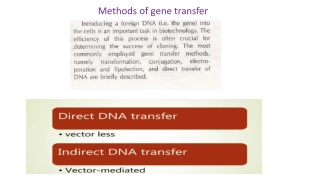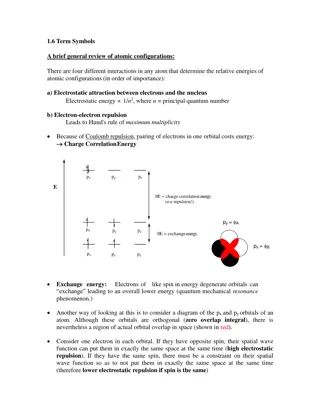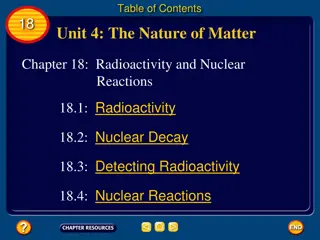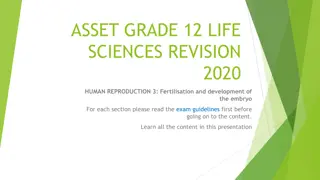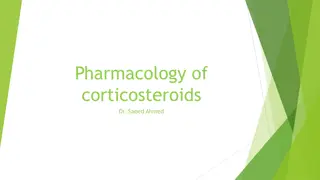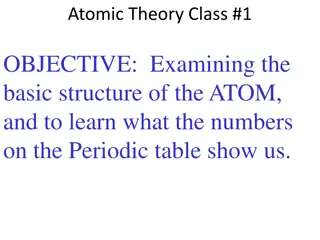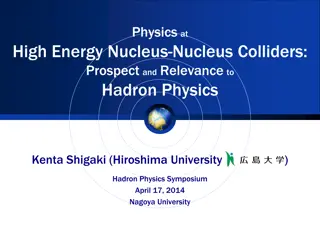Overview of Gene Transfer Methods in Molecular Biology
Explore various physical and chemical methods used for gene transfer, including electroporation, particle bombardment, microinjection, ultrasound, and bacterial transformation. Learn how DNA enters the nucleus and the role of retroviruses in gene transfer efficiency. Understand the process of RNA co
0 views • 17 slides
Understanding English Syllables: Structure and Description
Explore the concept of syllables in English phonetics through an in-depth analysis of syllabic structure, sonority, constituents, rhyme, nucleus, coda, and phonological perspectives. Delve into the definition of a syllable, its importance in speech production, and the phonetic descriptions of syllab
2 views • 38 slides
Understanding Models of the Atom: Nucleus, Protons, Electrons
Dive into the fundamental concepts of atoms, exploring their structure with a focus on the nucleus, protons, electrons, and neutrons. Discover how the periodic table reveals crucial information about elements, such as atomic number and mass number. Explore the evolution of atom models and the necess
3 views • 20 slides
Understanding Atomic Configurations and Term Symbols
The energy of atomic configurations is determined by electrostatic attraction between electrons and the nucleus, electron-electron repulsion, spin-orbit coupling, and spin-spin interactions. Term symbols in electronic spectroscopy specify atomic states using quantum numbers. Hund's rule and the Paul
8 views • 12 slides
Understanding Prokaryotic and Eukaryotic Cell Structure
This comprehensive guide explores the structures and characteristics of prokaryotic and eukaryotic cells. Learn about the differences and similarities between these cell types, including features like cell wall composition, membrane-bound organelles, nucleus presence, DNA structure, ribosomes, and m
7 views • 20 slides
Understanding Hyperfine Interactions in Atomic Physics
Hyperfine interactions play a crucial role in atomic physics, leading to small energy shifts and splitting of degenerate levels in atoms and molecules. These interactions involve the electromagnetic multipole interactions between the nucleus and electron clouds, resulting in the splitting of energy
13 views • 154 slides
Pascal's Rule in NMR Spectroscopy ( n+1 )
Pascal's Rule in NMR spectroscopy, also known as the (N+1) rule, is an empirical rule used to predict the multiplicity and splitting pattern of peaks in 1H and 13C NMR spectra. It states that if a nucleus is coupled to N number of equivalent nuclei, the multiplicity of the peak is N+1. The rule help
1 views • 30 slides
Understanding Radioactivity and Nuclear Reactions
Exploring the nature of matter, this chapter delves into radioactivity and nuclear reactions. It covers the composition of atoms, the nucleus with protons and neutrons, and the role of electrons. The strong force holding protons and neutrons together is highlighted, along with the detection of radio
1 views • 126 slides
Insights into Nuclear Core Dynamics and Structure
Exploring the dynamics of nuclear cores, this research delves into the intricacies of probing the NN repulsive core, modern NN potentials, and field theories of nucleons and mesons. The study encompasses the isospin dependence, non-nucleonic components, hidden color, and gluons within the nucleus, s
1 views • 63 slides
Pollen Grain Development
The process of pollen grain development and formation of the male gamete involves crucial stages such as the presence of diploid microspore mother cells in the stamen, meiosis resulting in the formation of four haploid cells and tetrads, mitosis leading to the development of two haploid nuclei in ea
0 views • 6 slides
Comprehensive Overview of the Nervous System
Explore the anatomy and functions of the nervous system with details on its subdivisions, brain parts, spinal cord features, cranial nerves, and more. Learn about sensory input collection, integration, and motor output functions. Understand the structural and functional organization of the central a
0 views • 23 slides
Understanding the Ultrastructure of Spermatozoa and Their Components
Explore the intricate details of spermatozoa and their structures, including the head, nucleus, acrosome, and more. Learn about the dimensions of mammalian spermatozoa and the principal parts that make up these essential reproductive cells.
0 views • 23 slides
Human Reproduction: Fertilisation and Embryo Development Overview
Human reproduction involves the complex processes of fertilisation and embryo development. Fertilisation occurs when the nucleus of a sperm cell fuses with the nucleus of an ovum to form a zygote. The zygote undergoes mitosis to develop into a blastocyst, which then implants into the endometrium. Th
0 views • 12 slides
Understanding Radioactivity and its Particles in Radiochemistry
Radioactivity involves the spontaneous decay of unstable atomic nuclei, releasing radiation in the form of alpha particles, beta particles, and gamma rays. Alpha particles are heavy and have low penetration, beta particles are light and faster, while gamma rays are high-energy waves with great penet
1 views • 20 slides
Understanding White Blood Cells and Their Classification
White blood cells (WBCs), or leukocytes, are vital elements of the blood responsible for protecting the body against invading organisms. They are classified into granulocytes (neutrophils, eosinophils, basophils) and agranulocytes (monocytes, lymphocytes), each playing specific roles in the immune s
1 views • 28 slides
Understanding NMR Spectroscopy of Paramagnetic Molecules
NMR spectroscopy of paramagnetic molecules is influenced by the presence of unpaired electrons, leading to broadened spectra and complex coupling mechanisms. Quadrupolar nuclei, with spins greater than 1/2, play a significant role in the relaxation and splitting of NMR signals. The interaction betwe
0 views • 19 slides
Exploring the Thermophilic Organisms: Thermoplasma Genus
The Thermoplasma genus belongs to Archaea and thrives in acidic, high-temperature environments. These prokaryotic organisms lack a defined nucleus and utilize sulfur and organic carbon for respiration. They possess a unique membrane composition, allowing them to survive in extreme conditions. Specie
0 views • 12 slides
Understanding Prolapsed Intervertebral Disc (PIVD)
The intervertebral disc, a crucial component of the spine, can be affected by prolapse, leading to various stages of PIVD. The condition involves the nucleus pulposus bulging out due to tears in the annulus fibrosis. The stages of PIVD include bulging disc, protrusion, extrusion, and sequestrization
0 views • 36 slides
Understanding Corticosteroids: Pharmacology and Effects
Corticosteroids, including glucocorticoids and mineralocorticoids, play vital roles in intermediary metabolism, immune responses, and inflammation regulation. They bind to specific receptors in the cell, entering the nucleus to influence gene transcription and protein production. These hormones have
14 views • 32 slides
Exploring Parts of the Atom: A Visual Journey
Delve into the discovery of the constituents of an atom, from the negatively charged particles in the electron cloud to the positively charged particles in the nucleus. Learn about protons, neutrons, and the particle with no charge as they form the building blocks of matter. Engage with visually sti
4 views • 17 slides
Understanding Organic Chemistry: Introduction to Carbon Compounds
Organic chemistry is the study of carbon compounds, with carbon's unique electronic structure allowing for a vast array of compounds. This field touches many aspects of life, from medicines to polymers. The nucleus of an atom, comprising protons and neutrons, is surrounded by electrons occupying orb
1 views • 5 slides
Understanding Nuclear Physics: Inside the Nucleus and its Impact
This content explores nuclear physics, covering topics like what's inside the nucleus, radioactivity, half-life, carbon dating, nuclear energy, fission, fusion, reactors, and weapons. It delves into the structure of the nucleus, radioactive decay processes, nuclear reactions, biological effects of r
0 views • 29 slides
Understanding Solid State Physics - Crystal Structures, Binding, and Nucleus Properties
Delve into crystallography, solid-state binding, semiconductor conduction, nucleus structure, and particle detectors in this comprehensive syllabus for Third Year T.D.C. Science students.
0 views • 16 slides
Understanding Diffraction Processes and Meson Production in Nuclear Interactions
Exploration of diffraction dissociation of nuclear nucleons in nucleus-nucleus interactions using Geant4 FTF model and NA61/SHINE results for various nucleus combinations. Insights into meson production in argon-nucleus interactions at different energies and the impact of models like DCM/AGT, UrQMD,
0 views • 17 slides
Understanding the Basic Structure of Atoms: Atomic Theory Class #1
Exploring the fundamental components of atoms, including protons, neutrons, and electrons, their charges, symbols, masses, and locations within the atom. We delve into the concept of atomic mass units (AMU) and the structure of the nucleus, as well as the behavior of electrons in relation to the nuc
0 views • 108 slides
The Rutherford Atom and Its Structure
The Rutherford atom is characterized by a thin circle of negative electrons surrounding a tiny positive nucleus. In this model, the electrons are in a diffuse cloud around the nucleus, forming the majority of the atomic volume but only a small fraction of the mass. Protons define an element's atomic
0 views • 17 slides
Exploring Atom Structure and Properties Questions
This series of questions delves into the intriguing world of atoms, covering topics such as atom size comparison, proton count identification, location of metals on the Periodic Table, nucleus charge explanation, atomic number significance, various arrangements of the Periodic Table, subatomic parti
0 views • 12 slides
Understanding Chromosome Territories in the Nucleus
Chromosome territories refer to specific regions in the nucleus where chromosomes are organized. While chromosomes appear as condensed structures during cell division, they have a different appearance in non-dividing cells like neurons. Scientists have used microscopy to study chromosome organizatio
0 views • 17 slides
Introduction to Histology and Cell Structure
Histology is the microscopic study of normal tissues utilizing light and electron microscopes. This field explores the composition and function of cells, focusing on the nucleus, cytoplasm, organelles, and inclusions. Thin tissue sections stained with Haematoxylin and Eosin reveal distinct cellular
0 views • 23 slides
Understanding Histology and Cell Structure Fundamentals
Delve into the intriguing world of histology and cell structure, exploring the composition of cells, the functions of various components like the nucleus and cytoplasm, and the significance of organelles. Discover how histology is studied, the types of microscopes used, and the vital role of the cel
0 views • 24 slides
Detailed Review of R-Alice PDS Data - Southwest Research Institute
Content discusses the R-Alice PDS data review conducted by Cesare Grava from Southwest Research Institute. It includes details on FUV imaging spectrograph specs, objectives of R-Alice, study goals related to comet nucleus, atomic budget analysis, and spectral mapping of 67P/CG nucleus at FUV wavelen
0 views • 14 slides
Exploring Quark-Gluon Plasma and New State of Matter at High Energy Colliders
Delve into the realm of high-energy physics at nucleus-nucleus colliders, with a focus on the discovery of deconfined partonic matter and the investigation of parallel worlds. Explore the recent insights, emerging topics, and new phenomena observed in ultra-intense collisions. Uncover the properties
0 views • 35 slides
Photoproduction of Pionic Atoms at the Gamma Factory: Research Overview
Research conducted by V. V. Flambaum, J. Jin, and D. Budker at the Gamma Factory (GF) on photoproduction of pionic atoms is detailed in this content. It explores the formation of pionic atoms with negative pions orbiting the nucleus in a hydrogen-like system, emphasizing strong interaction effects a
0 views • 11 slides
Exploring Molecular Biology and Cell Science
Molecular biology delves into the study of biology at the molecular level, focusing on gene structure and functions to comprehend hereditary traits, genetic variation, and gene expression patterns. Cells, the fundamental units of life, vary in shape and function but share basic structures. The Three
0 views • 31 slides
Comparison of Models of Nucleus-Nucleus Interactions in CORSIKA
Introduction to the study on models of hadronic interactions at high energies implemented in CORSIKA, a simulation tool used to analyze cosmic ray interactions with Earth's atmosphere. The study compares four widely used models, detailing their features and variants in simulation parameters. Results
0 views • 10 slides
Comparison of Eukaryotic and Prokaryotic Cells in Cell Biology
Cells are the fundamental units of life, but viruses are an exception as they lack cells. Eukaryotic cells have a defined nucleus with a nuclear membrane housing chromosomes, while prokaryotic cells lack a membrane-bound nucleus and other organelles. Eukaryotic cells are larger, containing membrane-
0 views • 9 slides
Evolution of Atomic Models: From Rutherford to Quantum Mechanics
Various atomic models have been proposed throughout history, starting with John Dalton's idea of atoms as tiny particles to J.J. Thomson's Plum Pudding model. Ernest Rutherford's discovery of the nucleus and Niels Bohr's quantum model of the atom revolutionized our understanding. Bohr's proposal of
0 views • 38 slides
Fascinating Vocabulary of Cell Biology
Explore the intricate world of cell biology through fancy terminology for basic cell components, such as the cell membrane, cytoplasm, mitochondria, nucleus, and more. Discover the unique functions and structures of plant and animal cells as compared to different types of cells within each class. Vi
0 views • 19 slides
Understanding Plant Cell Components: Nucleus, Cell Wall, Mitochondria, Cytoplasm, Chloroplasts
Plant cells consist of various components like the nucleus, cell wall, mitochondria, cytoplasm, and chloroplasts, each serving specific functions essential for the plant's growth and survival. The nucleus houses genetic information, the cell wall provides support, mitochondria produce energy, cytopl
0 views • 18 slides
Understanding DNA: The Building Blocks of Life
DNA, or Deoxyribonucleic Acid, is a fundamental chemical substance found in all cells of both plants and animals. It contains coded information necessary for organism development, using four base molecules - Uracil, Adenine, Thymine, Cytosine, and Guanine. These bases combine with phosphate and suga
0 views • 11 slides
